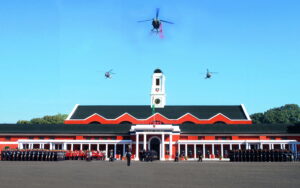Trishul Peak, located in the Indian Himalayas, is one of the most iconic and majestic peaks in the region. Its name, “Trishul,” translates to “trident” in Hindi, aptly describing the peak’s triple-summit appearance resembling the prongs of a trident. This stunning mountain is situated in the Kumaon region of Uttarakhand.
A Geographical Colossus
The Trishul massif, located in the western Kumaun region of Uttarakhand, is a geologically young mountain range formed due to the ongoing collision between the Indian and Eurasian tectonic plates. This immense pressure has thrust the rocks upwards, creating the dramatic peaks that dominate the landscape. The three summits of Trishul form a roughly north-south ridge, with Trishul I, the highest peak, at the northern end. Interestingly, the massif’s orientation significantly impacts how it appears from different viewpoints. From the south (towns like Ranikhet and Kausani), the three peaks appear compressed, while a more stretched-out view is offered from the southeast (villages like Chamoli and Bedni Bugyal).
The Trishul massif is not an isolated entity but exists within a grander Himalayan ecosystem. Surrounding peaks like Nanda Ghunti to the northwest and Mrigthuni to the southeast create a spectacular amphitheater. The Nanda Devi Sanctuary, a UNESCO World Heritage Site known for its pristine beauty and diverse flora and fauna, lies approximately 15 kilometers west-southwest of Trishul.
How to reach Trishul Peak
By Air
The nearest airport to Trishul Peak is the Jolly Grant Airport in Dehradun, Uttarakhand. From Dehradun, you can either hire a taxi or take a bus to reach the town of Joshimath, which serves as a base camp for expeditions to Trishul Peak.
By Train
The nearest railway station to Trishul Peak is the Haridwar Railway Station. From Haridwar, you can take a bus or hire a taxi to reach Joshimath.
By Road
Joshimath is well-connected by road to major cities in Uttarakhand and nearby states. You can either drive to Joshimath or take a bus from cities like Rishikesh, Haridwar, or Dehradun. The road journey from these cities to Joshimath offers scenic views of the Himalayan landscape.
Map of Trishul Peak
A Historical Climb
The Trishul Peak holds a significant place in the history of mountaineering. In 1907, British climber Tom Longstaff, along with guides Tej Singh and Hari Singh, achieved the remarkable feat of conquering Trishul I, marking the first successful ascent of a peak exceeding 7,000 meters in the entire world. This pioneering climb paved the way for future expeditions in the Himalayas and established Trishul as a challenging yet coveted objective for mountaineers.
Trishul continues to be a sought-after destination for experienced climbers. The ascent requires a high level of technical skill, physical fitness, and the ability to navigate treacherous glaciers and weather conditions. The standard climbing route involves establishing base camps, acclimatization climbs, and technical sections demanding ice climbing expertise. The challenging terrain and unpredictable weather make Trishul a formidable climb, even for seasoned mountaineers.
The Mythological Connection of Trishul
Beyond its geographical and mountaineering significance, Trishul holds deep cultural and religious importance in India. The name itself derives from the Trishula, the three-pronged trident wielded by Lord Shiva, one of the principal deities in Hinduism. The trishula symbolizes Shiva’s power over creation, preservation, and destruction. The three peaks of Trishul are seen as a manifestation of this divine weapon, further solidifying the mountain’s association with the Hindu faith.
Legends abound regarding Trishul. One popular tale narrates that Parvati, Shiva’s consort, desired a trident similar to her husband’s. Pleased by her devotion, Shiva created a reflection of his Trishula in the Himalayas, resulting in the Trishul peak. Another legend associates the peak with the churning of the cosmic ocean (Samudra Manthan) during which various celestial objects, including divine weapons, emerged.
Pilgrims visiting nearby shrines like Badrinath and Kedarnath often include Trishul in their spiritual journeys. The majestic peak serves as a powerful visual reminder of the divine and a symbol of Shiva’s immense power.
Exploring the Environs of Trishul
While the summit of Trishul beckons only the most seasoned climbers, the surrounding region offers opportunities for exploration and adventure for all. The Nanda Devi Sanctuary, nestled beside Trishul, is a paradise for nature enthusiasts. Trekking trails weave through meadows teeming with wildflowers, offering breathtaking views of the Himalayas.
The town of Auli, a popular ski resort, provides a base for witnessing the grandeur of Trishul. During clear weather, the three peaks dominate the skyline, forming a majestic backdrop for winter sports activities.
For those seeking cultural immersion, the region boasts numerous temples and pilgrimage sites. Visiting these sacred spaces allows visitors to experience the deep connection between the local communities and the Trishul Peak.
Conservation Concerns and a Sustainable Future
The Trishul massif faces challenges due to factors like climate change and increased human activity. Rising temperatures threaten the delicate Himalayan ecosystem, leading to glacial retreat and potential avalanches. It is crucial to implement sustainable practices and promote responsible tourism to preserve the pristine beauty of the region for future generations.
Conservation Efforts and a Sustainable Future
Several organizations are actively involved in protecting the Trishul massif and the surrounding Nanda Devi Sanctuary. Here’s a continuation of the previous section exploring these efforts and advocating for a sustainable future:
- The Nanda Devi National Park – Established in 1983, this national park encompasses the Trishul massif and the Nanda Devi Sanctuary. Strict regulations limit human activity within the park, helping to conserve the fragile ecosystem.
- Eco-tourism Initiatives – Promoting responsible tourism practices is crucial. Local communities are being encouraged to develop eco-lodges and offer guided nature walks that minimize environmental impact. This fosters economic opportunities for residents while promoting sustainable tourism.
- Scientific Research – Ongoing research by biologists, geologists, and glaciologists plays a vital role in understanding the threats posed by climate change. This research informs conservation strategies and helps predict and mitigate potential environmental hazards.
- Raising Awareness – Educational programs and community outreach initiatives are essential for raising awareness about the importance of conserving the Trishul region. Educating both local communities and tourists about responsible practices ensures the long-term sustainability of the region.
Conclusion
The Trishul Peak stands as a testament to nature’s grandeur, a formidable challenge for mountaineers, and a sacred symbol in Hindu mythology. Its towering presence serves as a constant reminder of the delicate balance of the Himalayan ecosystem. By supporting conservation efforts, promoting sustainable tourism practices, and fostering a deep appreciation for this unique landscape, we can ensure that the legacy of Trishul continues to inspire and captivate generations to come.
Faqs About Trishul Peak
1. How high is Trishul Peak, and what are its three summits?
Trishul Peak stands tall at an elevation of approximately 7,120 meters (23,359 feet) above sea level. It comprises three main summits: Trishul I, Trishul II, and Trishul III, each contributing to its iconic triple-summit appearance.
2. What is the best time of year to visit Trishul Peak?
The best time to visit Trishul Peak and the surrounding region is typically during the summer months, from May to September when the weather is relatively stable and conducive to trekking and mountaineering activities. However, weather conditions can still be unpredictable, so it’s essential to check local forecasts and plan accordingly.
3. What are the main challenges faced by climbers attempting to summit Trishul Peak?
Climbing Trishul Peak presents several challenges, including steep and technical terrain, high altitude, adverse weather conditions, and the need for proper acclimatization. Additionally, the remote location and limited infrastructure add to the logistical complexities of mountaineering expeditions in the area.
4. Are permits or permissions required to trek or climb Trishul Peak?
Yes, visitors to Trishul Peak may need to obtain permits or permissions from the relevant authorities, especially if entering protected areas such as the Nanda Devi Sanctuary. It’s essential to research and adhere to any regulations in place and obtain necessary permits before embarking on your journey.
5. What are some alternative activities or attractions near Trishul Peak?
In addition to trekking and mountaineering, visitors to the Trishul Peak region can explore nearby attractions such as Auli, a popular ski resort known for its stunning vistas and winter sports activities. The area also offers opportunities for nature walks, birdwatching, and cultural experiences in local villages.




